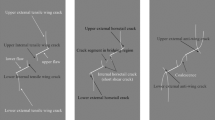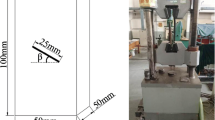Abstract
Cracking and coalescence behavior in a rectangular rock-like specimen containing two parallel (stepped and coplanar) pre-existing open flaws under uniaxial compression load has been numerically studied by a parallel bonded-particle model, which is a type of bonded-particle model. Crack initiation and propagation from two flaws replicate most of the phenomena observed in prior physical experiments, such as the type (tensile/shear) and the initiation stress of the first crack, as well as the coalescence pattern. Eight crack coalescence categories representing different crack types and trajectories are identified. New coalescence categories namely “New 1” and “New 2”, which are first observed in the present simulation, are incorporated into categories 3 and 4, and category 5 previously proposed by the MIT Rock Mechanics Research Group, respectively. The flaw inclination angle (β), the ligament length (L) (spacing between two flaws) and the bridging angle (α) (inclination of a line linking up the inner flaw tips, between two flaws) have different effects on the coalescence patterns, coalescence stresses (before, at or post the peak stress) as well as peak strength of specimens. Some insights on the coalescence processes, such as the initiation of cracks in the intact part of specimens at a distance away from the flaw tips, and coalescence due to the development and linkage of a number of steeply inclined to vertical macro-tensile cracks are revealed by the present numerical study.


















Similar content being viewed by others
References
Al-Busaidi A, Hazzard JF, Young RP (2005) Distinct element modeling of hydraulically fractured Lac du Bonnet granite. Journal of Geophysical Research-Solid Earth 110:BO6302
Asadi MS, Rasouli V (2011) PFC2D simulation of directionality in rough fractures shear strength. In: Proceedings of the 2th International FLAC/DEM Symposium, Melbourne, Australia
Bahaaddini M, Sharrock G, Hebblewhite BK (2011) A comparison of physical and numerical experiments on artificial jointed rock masses using PFC3D. In: Proceedings of the 2th International FLAC/DEM Symposium, Melbourne, Australia
Bobet A, Einstein HH (1998a) Fracture coalescence in rock-type materials under uniaxial and biaxial compression. Int J Rock Mech Min Sci 35(7):863–888
Bobet A, Einstein HH (1998b) Numerical modeling of fracture coalescence in a model rock material. Int J Fract 92(3):221–252
Brace WF, Paulding BW, Scholz C (1966) Dilatancy in the fracture of crystalline rocks. J Geophys Res 71(16):3939–3953
Cho N, Martin CD, Sego DC (2007) A clumped particle model for rock. Int J Rock Mech Min Sci 44(7):997–1010
Cundall PA (1971) A computer model for simulating progressive large scale movements in blocky rock systems. In: Proceedings of the symposium of the international society of rock mechanics, Nancy, France
Cundall PA, Strack OD (1979) A discrete numerical model for granular assemblies. Geotechnique 29(1):47–65
Diederichs MS (2000) Instability of hard rock masses: the role of tensile damage and relaxation. Ph.D. Thesis, University of Waterloo, Waterloo
Diederichs MS (2003) Manuel Rocha Medal recipient—rock fracture and collapse under low confinement conditions. Rock Mech Rock Eng 36(5):339–381
Erdogan F, Sih GC (1963) On the crack extension path in plates under plane loading and transverse shear. ASMEJ Basic Eng 85D:519
Fakhimi A (2004) Application of slightly overlapped circular particles assembly in numerical simulation of rocks with high friction angles. Eng Geol 74(1–2):129–138
Fakhimi A, Gharahbagh EA (2011) Discrete element analysis of the effect of pore size and pore distribution on the mechanical behavior of rock. Int J Rock Mech Min Sci 48(1):77–85
Fakhimi A, Villegas T (2007) Application of dimensional analysis in calibration of a discrete element model for rock deformation and fracture. Rock Mech Rock Eng 40(2):193–211
Ferrez JA (2001) Dynamic triangulation for efficient 3D simulation of granular material, PhD thesis, Ecole Polytechnique Federal de Lausanne, Lausanne
Fonseka GM, Murrell SAF, Barnes P (1985) Scanning electron microscope and acoustic emission studies of crack development in rocks. Int J Rock Mech Min Sci 22(5):273–289
Hazzard JF, Young RP, Maxwell SC (2000) Micromechanical modeling of cracking and failure in brittle rocks. J Geophys Res Solid Earth 105(B7):16683–16697
Hussain MA, Pu EL, Underwood JH (1974) Strain energy release rate for a crack under combined model I and mode II. ASTM STP 560:28
Ingraffea AR, Heuze FE (1980) Finite-element models for rock fracture-mechanics. Int J Numer Anal Meth Geomech 4(1):25–43
Itasca (2004) PFC2D (Particle Flow Code in 2 Dimensions) Version 3.1, Minneapolis
Khan SMA, Khraisheh MK (2000) Analysis of mixed mode crack initiation angles under various loading conditions. Eng Fract Mech 67(5):397–419
Khan SMA, Khraisheh MK (2004) A new criterion for mixed mode fracture initiation based on the crack tip plastic core region. Int J Plast 20(1):55–84
Lan HX, Martin CD, Hu B (2010) Effect of heterogeneity of brittle rock on micromechanical extensile behavior during compression loading. J Geophys Res Solid Earth 115:B01202
Lee H, Jeon S (2011) An experimental and numerical study of fracture coalescence in pre-cracked specimens under uniaxial compression. Int J Solids Struct 48(6):979–999
Li HQ, Wong LNY (2012) Influence of flaw inclination angle and loading condition on crack initiation and propagation. Int J Solids Struct 49(18):2482–2499
Martin CD, Chandler NA (1994) The progressive fracture of Lac du Bonnet granite. Int J Rock Mech Min Sci Geomech Abstr 31(6):643–659
Mas Ivars D, Pierce M, DeGagné D, Darcel C (2008) Anisotropy and scale dependency in jointed rock-mass strength: a synthetic rock mass study. In: Proceedings of the 1st international FLAC/DEM symposium, Minneapolis, USA
Menendez B, Zhu WL, Wong TF (1996) Micromechanics of brittle faulting and cataclastic flow in Berea sandstone. J Struct Geol 18(1):1–16
Mughieda O, Alzo’ubi AK (2004) Fracture mechanisms of offset rock joints: a laboratory investigation. Geotech Geol Eng 22(4):545–562
Ning YJ, Yang J, An XM, Ma GW (2011) Modelling rock fracturing and blast-induced rock mass failure via advanced discretisation within the discontinuous deformation analysis framework. Comput Geotech 38(1):40–49
Park CH, Bobet A (2009) Crack coalescence in specimens with open and closed flaws: a comparison. Int J Rock Mech Min Sci 46(5):819–829
Park CH, Bobet A (2010) Crack initiation, propagation and coalescence from frictional flaws in uniaxial compression. Eng Fract Mech 77(14):2727–2748
Park JW, Song JJ (2009) Numerical simulation of a direct shear test on a rock joint using a bonded-particle model. Int J Rock Mech Min Sci 46(8):1315–1328
Potyondy DO (2007) Simulating stress corrosion with a bonded-particle model for rock. Int J Rock Mech Min Sci 44(5):677–691
Potyondy DO, Cundall PA (2004) A bonded-particle model for rock. Int J Rock Mech Min Sci 41(8):1329–1364
Reyes O, Einstein HH (1991) Failure mechanism of fractured rock-a fracture coalescence model. In: Proceedings of the seventh international congress on rock mechanics, Aachen, Germany, pp 333–40
Sagong M, Bobet A (2002) Coalescence of multiple flaws in a rock-model material in uniaxial compression. Int J Rock Mech Min Sci 39(2):229–241
Sarmadivaleh M, Rasouli V (2010) Studying the controlling parameters in Hydraulic Fracturing and fracture containment in tight formations. APPEA J 50:581–591
Sarmadivaleh M, Rasouli V, Nabipour A (2011) A PFC2D simulation of hydraulic fracture and natural interface interaction. In: Proceedings of the 2th international FLAC/DEM symposium, Melbourne, Australia
Shen B, Stephansson O (1994) Modification of the G-criterion for crack-propagation subjected to compression. Eng Fract Mech 47(2):177–189
Shen B, Stephansson O, Einstein HH, Ghahreman B (1995) Coalescence of fractures under shear stresses in experiments. J Geophys Res Solid Earth 100(B4): 5975–5990
Shen B, Rinne M, Stephansson O (2006) FRACOD2D. User’s Manual ver 2.21, 2006. Fracom Ltd
Shi GH (1988) Discontinuous deformation analysis: a new numerical model for the static and dynamics of block systems. UC, Berkeley
Sih GC (1974) Strain energy density factor applied to mixed mode crack problems. Int J Fract 10(3):305–321
Tang CA, Lin P, Wong RHC, Chau KT (2001) Analysis of crack coalescence in rock-like materials containing three flaws—part II: numerical approach. Int J Rock Mech Min Sci 38(7):925–939
Tapponnier P, Brace WF (1976) Development of stress-induced microcracks in Westerly Granite International. J Rock Mech Min Sci 13(4):103–112
Thompson N, Mas Ivars D, Alassi HT, Pradhan S (2011) Investigation of the synthetic rock mass approach for the consideration of reservoir behavior. In: Proceedings of the 2th international FLAC/DEM symposium, Melbourne, Australia
Vasarhelyi B, Bobet A (2000) Modeling of crack initiation, propagation and coalescence in uniaxial compression. Rock Mech Rock Eng 33(2):119–139
Williams JR, Hocking G, Mustoe GGW (1985) The theoretical basis of the discrete element method, numerical methods of engineering, theory and applications NUMETA. AA Balkema, Rotterdam
Wong TF (1982) Micromechanics of faulting in westerly granite. Int J Rock Mech Min Sci 19(2):49–64
Wong NY (2008) Crack coalescence in molded gypsum and Carrara Marble. Ph.D. Thesis, Massachusetts Institute of Technology, Cambridge, p 876
Wong RHC, Chau KT (1998) Crack coalescence in a rock-like material containing two cracks. Int J Rock Mech Min Sci 35(2):147–164
Wong LNY, Einstein HH (2007) Coalescence behavior in Carrara marble and molded gypsum containing artificial flaw pairs under uniaxial compression. In: Proceedings of the first Can-US rock mechanics Symposium, Vancouver, pp 581–589
Wong LNY, Einstein HH (2009a) Crack coalescence in molded gypsum and Carrara marble—part 1. macroscopic observations and interpretation. Rock Mech Rock Eng 42(3):475–511
Wong LNY, Einstein HH (2009b) Systematic evaluation of cracking behavior in specimens containing single flaws under uniaxial compression. Int J Rock Mech Min Sci 46(2):239–249
Wong RHC, Chau KT, Tang CA, Lin P (2001) Analysis of crack coalescence in rock-like materials containing three flaws—part I: experimental approach. Int J Rock Mech Min Sci 38(7):909–924
Wong TF, Wong RHC, Chau KT, Tang CA (2006) Microcrack statistics, Weibull distribution and micromechanical modeling of compressive failure in rock. Mech Mater 38(7):664–681
Wu Z, Wong LNY (2012) Frictional crack initiation and propagation analysis by numerical manifold method. Comput Geotech 39:38–53
Wu JY, Zhu YS, Zhu HC (2011) A continuum representation and validation of time-dependent crack growth behavior of brittle rock. In: Proceedings of the 2th international FLAC/DEM symposium, Melbourne, Australia
Xia M, Zhou KP (2010) Particle simulation of the failure process of brittle rock under triaxial compression. Int J Min Metallurgy Mater 17(5):507–513
Zhang X-P, Wong LNY (2012) Cracking processes in rock-like material containing a single flaw under uniaxial compression- a numerical study based on parallel bonded-particle model approach. Rock Mech Rock Eng 45:711–737
Zhao C, Hobbs BE, Ord A, Robert PA, Hornby P, Peng Shenglin (2007) Phenomenological modelling of crack generation in brittle crustal rocks using the particle simulation method. J Struct Geol 29(6):1034–1048
Acknowledgments
The authors thank Professor Herbert Einstein and the reviewers for the valuable comments and helpful suggestions during the paper review process.
Author information
Authors and Affiliations
Corresponding author
Rights and permissions
About this article
Cite this article
Zhang, XP., Wong, L.N.Y. Crack Initiation, Propagation and Coalescence in Rock-Like Material Containing Two Flaws: a Numerical Study Based on Bonded-Particle Model Approach. Rock Mech Rock Eng 46, 1001–1021 (2013). https://doi.org/10.1007/s00603-012-0323-1
Received:
Accepted:
Published:
Issue Date:
DOI: https://doi.org/10.1007/s00603-012-0323-1




